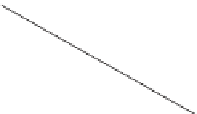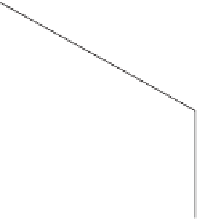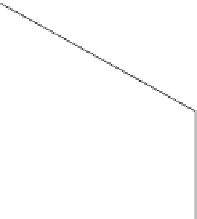Geoscience Reference
In-Depth Information
linearly varying flow across the channel, it is clear from the
Coriolis term 2
u
that the constant-velocity profile only
gives a constant acceleration across the channel and a cor-
responding constant (opposing) Coriolis force. However,
the linearly varying profile gives a linearly varying Cori-
olis acceleration across the channel and a corresponding
linearly varying Coriolis force, which for sufficiently high
Reynolds number leads to instability in the case of anticy-
clonic rotation, as in Figure 4.2. If the rotation is cyclonic,
then the Coriolis force is in the opposite direction and the
flow is stabilized instead.
Taylor-Couette low may fall into category (a) (and also
into category (b)). In this case streamline curvature also
affects the flow through the introduction of centrifugal
forces, and this is usually the dominant factor. However,
there are certain parameter ranges where the rotation
effects may be dominant, i.e., for corotating cylinders.
Another example where centrifugal effects may compete
with Coriolis effects is the pressure-driven
curved
chan-
nel flow. Pressure-driven curved channel flow is usually
denoted
Dean flow,
, and in that case the outer half of the
channel (concave-wall side) is unstable due to centrifu-
gal forces, and the instability may result in streamwise
vortices. Depending on the sign of the spanwise rotation
vector, the Coriolis force may either enhance or counter-
act the centrifugal force [
Matsson and Alfredsson
, 1990,
1994]. A similar centrifugal instability occurs for a bound-
ary layer flow over a concave wall, in that case denoted as
Görtler instability.
Category (b) includes a number of different flow classes
where, for example, the flow is set up by one or two rotat-
ing disks or cylinders with the fluid in between (see, e.g.,
the recent special volume edited by
Healey
[2007] where
studies of different disk flows are presented). One such
class is the so-called BEK (Bödewadt, Ekman, and von
Kármán) family of boundary layer flows (as defined by
Lingwood
[1997]). One of the first observations of this
type of flow was made by the Norwegian Arctic explorer
Fridtjof Nansen, who observed that the drift of surface ice
was angled at 20
◦
−
×
Ω
Ω
Channel flow
Von Kármán disk flow
Couette flow
Ω
Rotating pipe flow
Figure 4.1.
Schematics of different flow fields where rotation
effects are of importance.
U
w
=
+
2
b
-
U
w
y
Coriolis force
x
Figure 4.2.
Effects of
the Coriolis force on rotating plane
Couette flow.
destabilized and flow on the trailing side will be stabilized.
(The terms
leading
and
trailing
originate from turbo-
machinery where the “leading” side of a turbine or
compressor blade is the one approaching the flow.) The
stabilization and destabilization occur in both the laminar
and turbulent regimes for all these examples.
In this category of rotating flows, experiments on
pressure-driven channel flow have been carried out
by
Johnston et al.
[1972],
Lezius and Johnston
[1976],
and
Alfredsson and Persson
[1989], and experiments on
wall-driven plane Couette flow have been performed by
Alfredsson and Tillmark
[2005],
Hiwatashi et al.
[2007],
and
Tsukahara et al.
[2010a]. Some experiments on flat-
plate boundary layers with system rotation have also
been undertaken by
Watmuff et al.
[1985],
Masuda and
Matsubara
[1989],
Matsubara and Masuda
[1991], and
Nickels and Joubert
[2000].
As an example, the effect of the Coriolis force on a rotat-
ing flow is illustrated by Figure 4.2, which shows rotating
plane Couette flow. By dividing the plane Couette mean
flow into a superposition of a constant velocity and a
40
◦
to the right of the wind direction
(in the Northern Hemisphere) and correctly attributed
this effect to the fact that the Coriolis force introduced
by the rotation of Earth is not negligible compared with
the forces from the wind and current, which together
produce the slow drift velocity. Based on this sugges-
tion, the Swedish scientist Vagn Walfrid Ekman (as his
Ph.D. research) studied the influence of Earth's rotation
on wind-driven ocean currents, resulting from balanced
pressure gradient, Coriolis, and frictional forces.
Ekman
[1905] showed that the oceanic flow system, bounded by
the ocean surface, has a boundary layer structure within
which the mean velocity can be represented by a vec-
tor that changes length exponentially with depth below
the surface and changes angle linearly with depth, the





































































































































